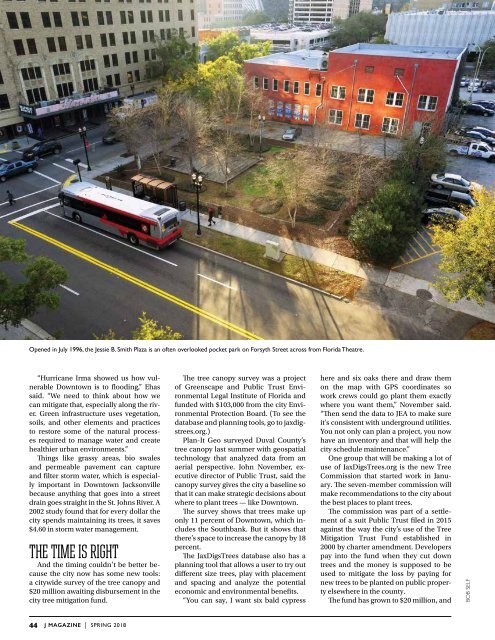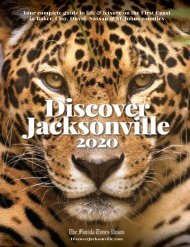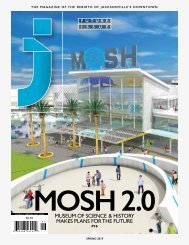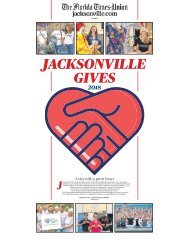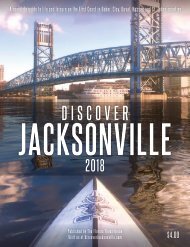J Magazine Spring 2018
You also want an ePaper? Increase the reach of your titles
YUMPU automatically turns print PDFs into web optimized ePapers that Google loves.
Opened in July 1996, the Jessie B. Smith Plaza is an often overlooked pocket park on Forsyth Street across from Florida Theatre.<br />
“Hurricane Irma showed us how vulnerable<br />
Downtown is to flooding,” Ehas<br />
said. “We need to think about how we<br />
can mitigate that, especially along the river.<br />
Green infrastructure uses vegetation,<br />
soils, and other elements and practices<br />
to restore some of the natural processes<br />
required to manage water and create<br />
healthier urban environments.”<br />
Things like grassy areas, bio swales<br />
and permeable pavement can capture<br />
and filter storm water, which is especially<br />
important in Downtown Jacksonville<br />
because anything that goes into a street<br />
drain goes straight in the St. Johns River. A<br />
2002 study found that for every dollar the<br />
city spends maintaining its trees, it saves<br />
$4.60 in storm water management.<br />
The time is right<br />
And the timing couldn’t be better because<br />
the city now has some new tools:<br />
a citywide survey of the tree canopy and<br />
$20 million awaiting disbursement in the<br />
city tree mitigation fund.<br />
The tree canopy survey was a project<br />
of Greenscape and Public Trust Environmental<br />
Legal Institute of Florida and<br />
funded with $103,000 from the city Environmental<br />
Protection Board. (To see the<br />
database and planning tools, go to jaxdigstrees.org.)<br />
Plan-It Geo surveyed Duval County’s<br />
tree canopy last summer with geospatial<br />
technology that analyzed data from an<br />
aerial perspective. John November, executive<br />
director of Public Trust, said the<br />
canopy survey gives the city a baseline so<br />
that it can make strategic decisions about<br />
where to plant trees — like Downtown.<br />
The survey shows that trees make up<br />
only 11 percent of Downtown, which includes<br />
the Southbank. But it shows that<br />
there’s space to increase the canopy by 18<br />
percent.<br />
The JaxDigsTrees database also has a<br />
planning tool that allows a user to try out<br />
different size trees, play with placement<br />
and spacing and analyze the potential<br />
economic and environmental benefits.<br />
“You can say, I want six bald cypress<br />
here and six oaks there and draw them<br />
on the map with GPS coordinates so<br />
work crews could go plant them exactly<br />
where you want them,” November said.<br />
“Then send the data to JEA to make sure<br />
it’s consistent with underground utilities.<br />
You not only can plan a project, you now<br />
have an inventory and that will help the<br />
city schedule maintenance.”<br />
One group that will be making a lot of<br />
use of JaxDigsTrees.org is the new Tree<br />
Commission that started work in January.<br />
The seven-member commission will<br />
make recommendations to the city about<br />
the best places to plant trees.<br />
The commission was part of a settlement<br />
of a suit Public Trust filed in 2015<br />
against the way the city’s use of the Tree<br />
Mitigation Trust Fund established in<br />
2000 by charter amendment. Developers<br />
pay into the fund when they cut down<br />
trees and the money is supposed to be<br />
used to mitigate the loss by paying for<br />
new trees to be planted on public property<br />
elsewhere in the county.<br />
The fund has grown to $20 million, and<br />
BOB SELF<br />
44<br />
J MAGAZINE | SPRING <strong>2018</strong>


